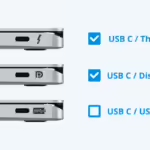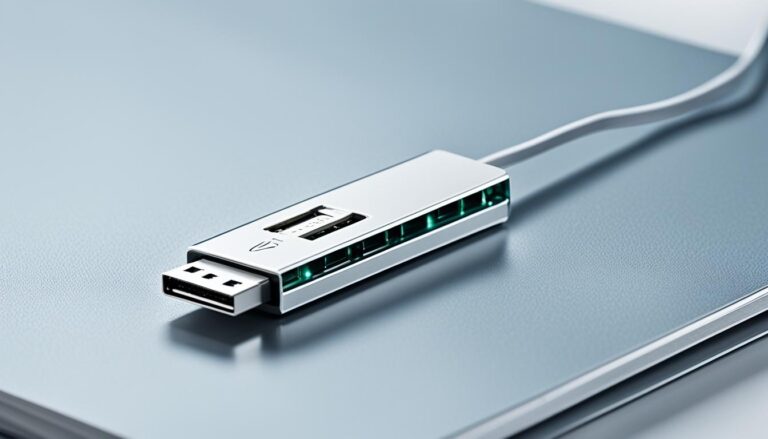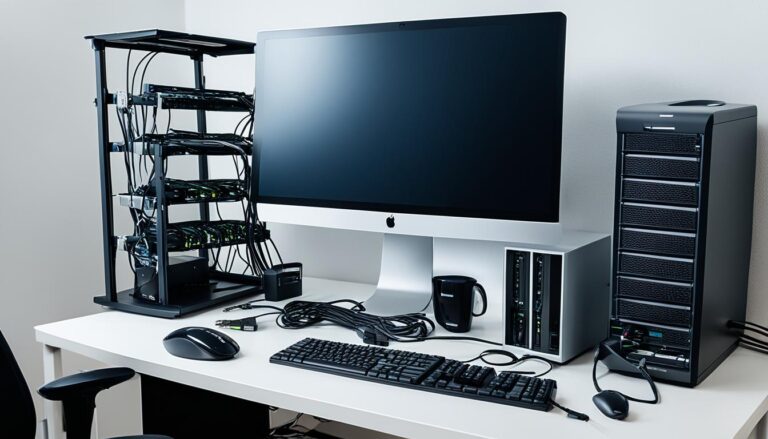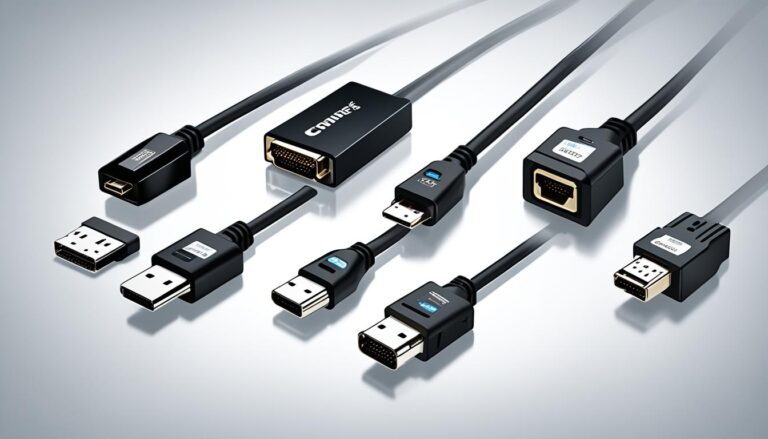Our brains love visual cues when learning about complex systems. That’s the power of a computer port symbols chart. It’s a visual guide that shows the symbols for different computer ports. This makes understanding the connections on modern devices easier.
For anyone interested in tech, being a computer technician, or just wanting to know about device ports, this chart is key. It visually explains the ports found on computers, laptops, tablets, and other gadgets. Now, you can easily spot and connect the correct cables and accessories.
This guide lets you skip the confusion and manual reading. You can now understand computer ports quickly and with confidence. Forget the old struggles of finding the right port. This chart simplifies everything for you.
If you’re keen to crack the code of computer ports, this chart awaits. It’s your chance to learn more, fix problems faster, and become an expert in computer connections. Let’s dive into the computer port symbols chart today.
What is a Flowchart?
A flowchart is a way to show a process or system through drawings. It uses different symbols and lines to describe steps and how they connect. You’ll see shapes like rectangles and ovals which each have their own meaning. Lines and arrows guide you through from beginning to end.
Flowcharts are used in many areas to help document and improve complex tasks. They make it easier to understand and share detailed processes. These diagrams are very helpful in business and tech, showing everything clearly.
In work like business planning or software design, flowcharts are key. They turn complicated ideas into simple, clear steps. This helps everyone understand and follow along.
Flowcharts are great for showing how a process works from start to end. They use special symbols to point out choices, actions, and results. Notes can be added to explain things in more detail.
“A flowchart is a powerful tool that not only helps visualize complex processes but also facilitates communication and understanding across teams and stakeholders.” – Jennifer Smith, Process Improvement Expert
Flowcharts are very important for making better decisions and streamlining work. They help us see and understand complex tasks easily. This makes them essential in many fields for improving how things are done.
A Brief History of Flowcharts
Flowcharts started in the 1920s and 30s. Frank and Lillian Gilbreth introduced Flow Process Charts in 1921. These charts soon became the base for modern flowcharting. By the 1940s, these charts were key for improving business processes. The Gilbreths used them to better understand workflows in different industries. They helped make production processes smoother.
As computer programming began, flowcharts became vital. They were used to outline algorithms and the logic of programs. Herman Goldstine and Jon Von Neumann also relied on flowcharts. They used them as visual guides when creating computer programs.
Flowcharts weren’t just for programming. In manufacturing, they played a big role in quality control. They made it easy to see where problems might occur in a process. By using flowcharts, it became simpler to spot and fix these issues. This has made them key in enhancing quality and streamlining operations.
Flowcharts have grown and changed. They now use a range of symbols and techniques. Today, they are invaluable in many industries. They help with documenting practices and improving processes. Flowcharts make complex information easy to understand, boosting efficiency.
In the next section, we will talk about different flowchart types. We will see how they are used in various areas.
“Flowcharts provide a visual representation that enhances comprehension and drives efficiency.”
Types of Flowcharts
Flowcharts are a universal tool for displaying various processes and systems. They are sorted by their use and purpose. This helps us understand how they work in different areas. Below are some common kinds of flowcharts:
Document Flowcharts
Document flowcharts show how papers move within an organization. They give a clear picture of how documents and info pass through different areas or people.
Data Flowcharts
Data flowcharts track data movement in a system. They focus on how data comes in, goes out, and changes. This shows how information is handled and used within the system.
System Flowcharts
System flowcharts depict the overall system or process. They show all major parts and how they connect. These flowcharts give a broad view of the system. They help spot problems or areas to make better.
Program Flowcharts
Program flowcharts display the steps of computer programs. They detail the actions and decisions in program running. This helps programmers see the logic of their code.
Swimlane Flowcharts
Swimlane flowcharts split up different groups or systems in a process. They show who does what. This makes it easy to see where people need to work together or where things could be better.
Workflow Flowcharts
Workflow flowcharts show the steps to finish a task. They map the activity flow from beginning to end. This helps spot any hold-ups, delays, or unnecessary steps.
Cross-Functional Flowcharts
Cross-functional flowcharts, or swimlane charts, show how different groups work together in a process. They offer a full view of the workflow. This highlights the interactions and handovers between various groups.
Event-Driven Process Chain Flowcharts
Event-driven process chain (EPC) flowcharts model and improve business processes. They focus on events that start actions in a process. This gives a clear view of how things are linked within the system.
Specification and Description Language Flowcharts
Specification and Description Language (SDL) charts are for system engineering and software creation. They map out how different system parts interact. This helps design and build complex hardware or software.
These flowchart types offer various ways to show, analyse, and enhance processes and systems. Whether it’s about showing document flow, data movement, or program steps, flowcharts give a clear and engaging way to look at complex processes.
How Many Flowchart Symbols are there?
There isn’t a set number of flowchart symbols since sources vary. But, understanding what each symbol means is key. This knowledge helps make clear process maps and data flow diagrams.
Symbols like rectangles, ovals, and diamonds each have a distinct meaning. By using them wisely, you can clearly show complex business steps.
Knowing what the symbols represent is vital. It makes process maps and data flow diagrams easy to follow. This simplifies business processes and supports good decision-making.
The Importance of Flowchart Symbols in Process Maps
Process maps visually show a workflow’s steps and decision points. Flowchart symbols are crucial for this. They clearly outline every part of the process.
With flowchart symbols, process maps become a powerful tool. They highlight issues, such as bottlenecks and redundancies. This helps improve business operations.
Flowchart Symbols in Data Flow Diagrams
Data flow diagrams track how data moves through a system or process. They use symbols to show data stages.
These symbols make the diagrams easy to understand for everyone. Teams can see where data goes, aiding communication and teamwork.
The symbols might change a bit based on the situation. But their main aim is always to show process flows easily. This helps everyone grasp and follow the process better.
Below is an example of commonly used flowchart symbols:
| Symbol | Meaning |
|---|---|
| Rectangles indicate a process or action step | |
| Ovals represent the start and end of a process | |
| Diamonds denote decision points in the process | |
| Parallelograms symbolize input or output | |
| Arrows illustrate the flow and direction of the process |
Remember, the main thing with flowcharts is to know your symbols. Use them right to make clear and useful process maps and diagrams. This helps everyone make better choices.
What is the Most Important Flowchart Symbol?
There’s no single symbol in flowcharts that’s seen as the most crucial. However, the process symbol and the decision symbol are very important. The process symbol shows a step or action. The decision symbol marks where a choice is made. Both are key for showing how a process works. What matters most changes based on the process itself.
Process Symbol
The process symbol looks like a rectangle. It’s there to point out an action or step. This symbol is about tasks that keep the process going. It makes the steps clear and shows the order of actions.
Decision Symbol
The decision symbol is diamond-shaped. It shows where a choice might change the process’s path. This symbol is good for seeing possible results and their routes. It makes understanding choices in a process simpler.
Using the process and decision symbols is vital for explaining process flows. They help make complex processes easier to grasp. Flowcharts become a tool for better understanding, assessing, and enhancing processes.
| Symbol | Meaning |
|---|---|
| Process Symbol | Represents a step or action in the process. |
| Decision Symbol | Represents a decision point with multiple possible outcomes. |
How to Create Better Flowcharts
Creating better flowcharts needs consistent symbols. Use the same shapes for starting and ending. Keep the size and spacing of all symbols the same. Make sure connectors are clear. This makes the flowchart clear and easy to understand.
It’s important to fit your flowchart on one page. This avoids the need to flip through many pages. A single-page flowchart lets people see the whole process at once. It makes the flowchart easy to use and understand.
For complex diagrams, use split paths instead of many decision symbols. Split paths show different options more clearly. They keep the diagram tidy. This makes flowcharts simpler and easier to follow.
Use predefined symbols and templates to save time. Many tools offer a wide range of these. They help start your diagrams quickly. And they keep your designs consistent.
By using consistent symbols, single-page layouts, split paths, and predefined resources, you can make better flowcharts. Such flowcharts are easier to understand. They help with communication and decision-making in many areas.
Key Strategies for Creating Better Flowcharts:
- Use consistent flowchart symbols throughout the diagram
- Maintain the flowchart on a single page
- Consider using split paths in complex flowcharts
- Utilize predefined symbols and templates
“Consistency in flowchart symbols, adherence to single page diagrams, strategic use of split paths, and the utilization of predefined symbols and templates are key strategies for creating better flowcharts.”
Conclusion
Flowcharts are essential for breaking down and grasping complex business processes. They use symbols and connectors to show the steps and order of a process. This makes it simpler to follow and understand. Flowcharts come in many types, each serving different purposes, such as studying, planning, improving, or sharing business processes.
Creating straightforward and consistent flowcharts improves understanding of processes. They map out each step and decision point. This acts as a visual guide for refining and streamlining how things are done. Flowcharts are great for examining how information moves in systems or showing detailed workflows.
The computer port symbols chart shows how flowcharts make complex ideas simpler. By using standard symbols for computer ports, it acts as a guide. This makes it easier to understand and fix issues with computer connections. It’s helpful to both IT experts and casual users.
FAQ
What is a flowchart?
A flowchart shows you how a process works, step by step. It has symbols, lines, and notes for clear explanations. It tells you what happens next in a process or system.
How many types of flowcharts are there?
Many flowcharts exist, each with its purpose. You’ll find document, data, system, and program flowcharts. There are also swimlane and workflow charts, cross-functional, event-driven, and language specification flowcharts.
What is the importance of consistent flowchart symbols?
Consistency in symbols makes a flowchart easy to understand. Use the same shapes for starting and ending, and keep all symbols the same size. Clear connectors are also crucial.
How can I create better flowcharts?
For good flowcharts, keep symbols consistent across the chart. Aim to fit your chart on one page for simplicity. Use splits for complex paths. Templates and predefined symbols help too.
What is the purpose of a flowchart?
Flowcharts visually break down a process. They make it simpler to follow and grasp. They’re useful for documenting, studying, improving, and sharing processes that are complex or large.












